10.08.20
Glen Moray Distillery & The 2020 Distillery Edition
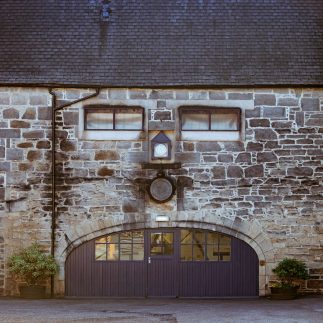
A single focus on Glen Moray for this column. As mentioned last time, they kindly sent samples of this year’s Distillery Edition collection. Rather than just placing three tasting notes in a longer column I thought it would be better to put them in context with some words about the distillery too and, to that end, I’ve had a long chat with Global Brand Ambassador and Visitor Centre Manager, Iain Allan who was wonderfully informative and enthusiastic. Iain has been at Glen Moray, on the west side of Elgin, for 15 years, having been visitor manager at another Speyside distillery before that.
Glen Moray was converted from a brewery to a distillery and opened in 1897 around the same time as Ardmore and Tomatin. It was owned by Robt. Thorne & Sons who were still the owners on its conversion. I wondered why they should make this move as I thought brewing would have been a lucrative activity. Wrong! Iain advised that, although Elgin had been a brewing town, it was not fashionable at that point and many were closing. Also, as we know, it’s not a massive change to make from brewing to distilling. We agreed that it may also have had much to do with the distilling boom created by the seeming whisky wealth being made by the Pattison brothers before it all came crashing down the following year when their fraudulent activities were exposed.
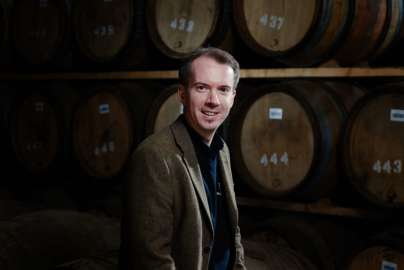 In the 15 years Iain has been at Glen Moray he’s seen massive changes, apart from new owners. From my point of view, Glen Moray, as owned by The Glenmorangie Company always seemed to be a distant third behind Glenmorangie and Ardbeg – they didn’t seem to know quite what an asset they had (seen that in other companies too). Iain reckons it’s a shame but they did look after Glen Moray very well. A lot of the production went into own label whiskies. Iain tells that La Martiniquaise, the current owners since 2008, have invested a lot in the site to develop production from 2.2 million litres of alcohol to 6 million today. It was done in two stages, part of it in 2012 to raise output to 3.3 million l.o.a. and then again a few years later when the old maltings were knocked down and more production space added. Three new wash stills with greater capacity came in and wash stills were converted to spirit stills so there is now a ratio of 1 wash:2 spirit rather than 1:1.
In the 15 years Iain has been at Glen Moray he’s seen massive changes, apart from new owners. From my point of view, Glen Moray, as owned by The Glenmorangie Company always seemed to be a distant third behind Glenmorangie and Ardbeg – they didn’t seem to know quite what an asset they had (seen that in other companies too). Iain reckons it’s a shame but they did look after Glen Moray very well. A lot of the production went into own label whiskies. Iain tells that La Martiniquaise, the current owners since 2008, have invested a lot in the site to develop production from 2.2 million litres of alcohol to 6 million today. It was done in two stages, part of it in 2012 to raise output to 3.3 million l.o.a. and then again a few years later when the old maltings were knocked down and more production space added. Three new wash stills with greater capacity came in and wash stills were converted to spirit stills so there is now a ratio of 1 wash:2 spirit rather than 1:1.
We’re told La Martiniquaise have also shifted the focus very much to brand-building and exporting and it’s “gone gangbusters” to quote Iain. They moved on from Classic, 12 and 16 to create ranges, now having Classics, Heritage, Curiosity and some special releases. See all current ranges at www.glen-moray.co.uk . The distillery still has some reciprocal agreements in place with other companies to trade for its own blending purposes. It is also a key component of sister brand, Label 5, a big seller in France especially.
I haven’t tried Glen Moray new make so asked Iain to describe it. It comes from “relatively small stills and a low level lyne arm” and Iain goes on to praise it as versatile, with fruity, sweet toffee apple notes, good viscosity, easy to drink straight off the vat and, when mature, works at many ages. The whiskies shown on the website are primarily bourbon matured but they obviously use other casks, mainly for finishes with some exceptions. They do put new make straight into sherry casks but not 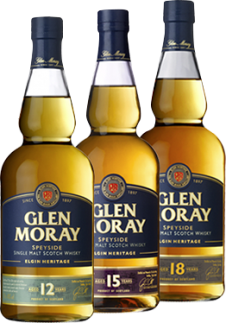 100% sherry matured in the core range, though that could change. Some of the sherry casks used are U.S. oak rather than European. The 15 Year Old in the Heritage range is US oak and sherry wood mix and that does NOT mean just finish. It’s a 50:50 bourbon and sherry wood with the respective casks holding those whiskies for the full 15 years before being married together for bottling. The current 18 year old contains no sherry cask whiskies, despite the website indicating a note of “sherried oak” (as of 8th August, 2020). It’s seemingly a recent change.
100% sherry matured in the core range, though that could change. Some of the sherry casks used are U.S. oak rather than European. The 15 Year Old in the Heritage range is US oak and sherry wood mix and that does NOT mean just finish. It’s a 50:50 bourbon and sherry wood with the respective casks holding those whiskies for the full 15 years before being married together for bottling. The current 18 year old contains no sherry cask whiskies, despite the website indicating a note of “sherried oak” (as of 8th August, 2020). It’s seemingly a recent change.
I asked about the chardonnay and chenin blanc finishes that came out in the late 90’s as that was a novel move at the time, under the Glenmorangie watch. Iain says it was the work of the Master Distiller at the time who was told to clear out that wood but quietly went against corporate wishes and filled them again with Glen Moray. That was the birth of the 10 year old chardonnay cask released later on (see next para). Iain doesn’t know why it was those two types of cask that were used but says it was a time when Glenmorangie Company was using Glen Moray as a guinea pig for wood trials (and much credit to them for that). He reckons they were maybe too far ahead of the curve the first time (1999) as it had a lukewarm reception from trade and consumers who didn’t quite understand it. How things change when we now have wine cask finishes and full maturation from many places. It was pulled from the market as it didn’t improve sales.
Given that wood experimentation, I asked about Glen Moray’s Classic range of wine finishes and whether these were underway before La Martiniquaise took ownership. Certainly the 10 Year Old Chardonnay was already in stock and released in 2009, the year after they purchased Glen Moray. Activities and offerings now involve a mix of legacy cask stock and new development. Having a French owner has certainly helped in sourcing wine casks now and La Martiniquaise has much expertise in port wine casks, too, with access to full cask provenance.
In terms of market positions, Glen Moray claims No. 5 position in the UK with the likes of Glenfiddich, Laphroaig, Glenmorangie and Macallan to clamber over to get to the top. Some of this may be down to its very keen pricing in supermarkets but don’t think this means it is an insipid or ill-wrought, value-for-money brand created for supermarket sales. It certainly is not. Many malts are competing in that environment and if keen pricing can be offered then the consumer benefits. Key world markets for the brand are UK, USA and Australia. Indeed, the brand is now exported to over 50 countries. Hence the need for Iain to have added the brand ambassadorial role to his portfolio which wasn’t needed before. It’s obviously something he enjoys and says he just does the same job whether at the distillery or out in the wider world. He added that the nice thing about the world role is that he sometimes sees those he met abroad coming to visit the distillery later on.
I wondered how things were going in the current lockdown situation, even though things have opened 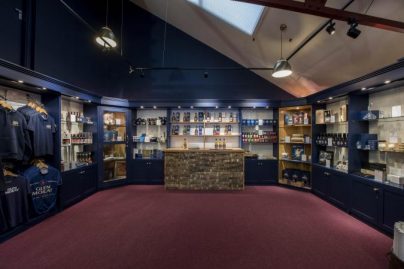 up a little. As of 15th July, the distillery’s visitor centre opened up again but not for tours. That will take a bit longer and Iain is of the opinion it could even last the rest of the year, though things are carefully monitored. At the moment, the shop, coffee shop and tasting flight sessions are available but café and tasting slots must be booked in advance due to limited places. Lockdown must have meant a huge revenue loss to a distillery which welcomed some 24,000 visitors last year. However, thanks to telephone orders (see below), one day recently was as good as a normal summer from a revenue point of view. The visitor centre re-opening has been with a team of 4 from the permanent core staff. Two others are on maternity leave. Sadly, they would normally have a main season complement of 14 but there’s no need for seasonal guides this year.
up a little. As of 15th July, the distillery’s visitor centre opened up again but not for tours. That will take a bit longer and Iain is of the opinion it could even last the rest of the year, though things are carefully monitored. At the moment, the shop, coffee shop and tasting flight sessions are available but café and tasting slots must be booked in advance due to limited places. Lockdown must have meant a huge revenue loss to a distillery which welcomed some 24,000 visitors last year. However, thanks to telephone orders (see below), one day recently was as good as a normal summer from a revenue point of view. The visitor centre re-opening has been with a team of 4 from the permanent core staff. Two others are on maternity leave. Sadly, they would normally have a main season complement of 14 but there’s no need for seasonal guides this year.
I asked Iain what, for him, is the essence of Glen Moray – what makes it special and stand out? He likes the fact that people discover it with little or no preconception. “People drink it and talk about it. It always surprises them in a good way. It’s a wonderful spirit.” Also, that it doesn’t just do well in supermarkets as there are a lot of sides to what they do. He also paid tribute to the people who work there as well as to the special nature of the place. I put the same question to Kirstie McCallum and her response was, “The essence of Glen Moray for me is the soft fruit notes, and touch of oiliness which makes it a great whisky for working with different cask types. It’s also the people and the place itself, everyone is so friendly and welcoming.”
Lastly, I’d asked both Iain and Kirstie about future projects if there are any they can tell us about 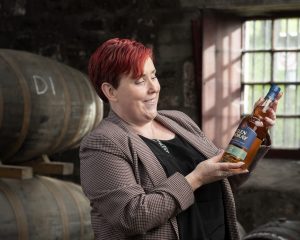 now. Iain mentioned that a Sauternes cask expression will be out in December which he is “super-excited” about. That will certainly be in the UK market. He also mentioned the Curiosity series. For Kirstie, “There are lots of new and interesting things happening at the moment. I’ve been searching for a particular cask type for a long time, over 12 years, and I’ve finally managed to find them. The whisky has been in them now for two months and it’s looking extremely positive. Sherry doesn’t play a big part in the traditional DNA of Glen Moray, so I’ve started to experiment with different sherry types to see the interaction between the different flavours and Glen Moray. I’ve also been doing a bit of experimentation with Italian wine casks.” So we consumers definitely have a lot to look forward to.
now. Iain mentioned that a Sauternes cask expression will be out in December which he is “super-excited” about. That will certainly be in the UK market. He also mentioned the Curiosity series. For Kirstie, “There are lots of new and interesting things happening at the moment. I’ve been searching for a particular cask type for a long time, over 12 years, and I’ve finally managed to find them. The whisky has been in them now for two months and it’s looking extremely positive. Sherry doesn’t play a big part in the traditional DNA of Glen Moray, so I’ve started to experiment with different sherry types to see the interaction between the different flavours and Glen Moray. I’ve also been doing a bit of experimentation with Italian wine casks.” So we consumers definitely have a lot to look forward to.
I’d been told that the Distillery Editions I’m looking at here were Iain’s idea and asked about the inspiration. Basically, it was something requested by visitors who wanted something exclusive they couldn’t buy in their home markets. The first one came out in 2006, the year after his arrival. Initially these were single cask offerings but Iain likes collections and so, since 2018, has made them sets that people could buy when visiting. The first was all 1994 whiskies, the second featured PX finishes and this year they are all wine cask maturation – and that doesn’t mean finishes. The 2020 Distillery Editions have been fully matured in the featured wine casks. All are 16 – 17 years old. Iain says they found favour across the board with the distillery team – no one “showstopper” amongst them which 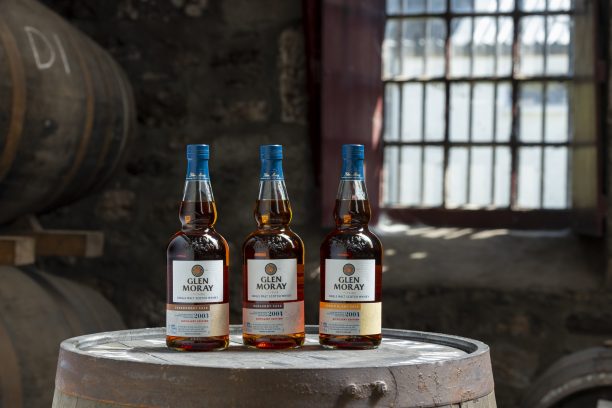 he reckons is the mark of a good, cohesive collection. They are available through a novel “Dial a Dram” initiative live till the end of August (tel ++ 44 1343 550900 from outside the UK and 01343 550900 within the UK) as they wanted a much more personal touch than online and virtual events going on elsewhere or impersonal online ordering. Consumers can phone in for a consultation/chat with one of the team of four currently there. Apart from this collection, people can be guided through the range, be given recommendations, have questions answered and have an order taken by an actual person. A brilliant idea and Iain credits their PR agency, Burt Greener, with the idea as and those at the distillery for setting up and running it.
he reckons is the mark of a good, cohesive collection. They are available through a novel “Dial a Dram” initiative live till the end of August (tel ++ 44 1343 550900 from outside the UK and 01343 550900 within the UK) as they wanted a much more personal touch than online and virtual events going on elsewhere or impersonal online ordering. Consumers can phone in for a consultation/chat with one of the team of four currently there. Apart from this collection, people can be guided through the range, be given recommendations, have questions answered and have an order taken by an actual person. A brilliant idea and Iain credits their PR agency, Burt Greener, with the idea as and those at the distillery for setting up and running it.
So how does the 2020 Distillery Edition collection nose and taste? There are three of them Chardonnay, Chenin Blanc and Burgundy casks. All are at cask strength with natural colour and have not been chill-filtered. I wasn’t sure if the Burgundy cask was red or white Burgundy as it’s the palest of the three, though all are very similar in colour. However, I did wonder what would be the point of a white Burgundy expression as the white Burgundy grape is chardonnay and there’s already one of those here. I did also consider whether the Chardonnay Cask version might be from elsewhere in the world where chardonnay is successfully cultivated. As it happens, it is a red Burgundy (pinot noir) cask but displays none of the aromas you might expect from that.
Glen Moray Distillery Edition Chardonnay Cask (2003 – 58.9% abv)
Appearance: Rich medium amber with burnt orange highlights. The viscosity/oiliness is obvious with tears quite, slow and sticky.
Nose: Very sweet toffee/caramel notes leap out of the glass – like tablet too (a Scottish sweet). Really enticing. A hint of coconut and some warm vanilla and sweet oak wood. Very slightly vinous. Apple, melted butter, sultanas and honey – strudel in a glass! With water the oiliness is much more apparent as you swirl the glass. A note of white pepper. More apple and oak with a dab of apricot. Baked pineapple, sweet spices and that honey again. Toasty and buttery with a creamy walnut streak.
Palate: Sweet then very swiftly mouth-drying. Good viscosity. A bitter cherry note but also warm and buttery. Some burnt toffee/caramel. Citrus zest spritz and bitterness. It leaves the tongue tingling. Then oak tannins come through along with toasted notes.
Finish: Long and lingering barley cereal sweetness with burnt caramel. Also very dry with herbs and savoury spices. Wait a little and the oak kicks in too.
Glen Moray Distillery Edition Chenin Blanc Cask (2004 – 60.3% abv)
Appearance: Also rich amber but with a fractionally paler heart. Stickier tears than the Chardonnay expression. Chenin blanc can be quite a luscious grape so this has been part of the grape effect still present in the cask.
Nose: A “drier” nose than the chardonnay with a sulphur, almost onion, note. An aroma of wine gum ( a classic chenin blanc feature); apple peel and spicy florals. Some warm, sawn oak notes. Initially it was a bit more closed and austere than the chardonnay but, as it sits, more of the toffee apple comes through. With water, a bit more sulphur and a slightly meaty, cooked ham note. Creamy cheese and the wine gums peek through. Honey again here. Sweet green herbs and some leafy vegetation. The meatiness and vegetal notes disappear leaving lemon pepper and sweetness.
Palate: A luscious mouth feel. Some sulphury, meaty notes. Then in come almonds and gingery, warm spices with some oak. This one has quite a forthright nature.
Finish: Medium – long; toasted cereal and slight sulphur then oak wood. It finishes very dry on the tongue but warming and sweetly spiced.
Glen Moray Distillery Edition Burgundy Cask ( 2004 – 60.1% abv)
Appearance: Paler amber with more of a deep yellow base and apricot highlights. Tears are slow and inch down the glass.
Nose: Sweet toffee notes again followed by the apple signature. A very fresh and “airy” nose. Sweet marshmallow and a bit of bubblegum. Damp oak and baked strudel. Apart from earthiness, none of the classic red burgundy notes of farmyards, truffle or violet. A little redcurrant. With water, a bit more closed at first then more maturation warehouse notes of damp oak and earthen floors. Fruit juices, citrus zest, sultanas and apricots. Honey and orange blossom. A little hint of almond essence and green peppers. Maybe even a little lavender note.
Palate: Slightly luscious mouth feel but very mouth drying. Earthiness; also almond notes; a bit of honey and sweet spices; rich oak. Toasted barley; dark chocolate and a little waft of black coffee.
Finish: Long with oak and vanilla sweetness but very drying. Delicious barley notes and a slight licorice aftertaste.
Iain asked to know if I had a favourite. Well, the Chardonnay Cask had me at ”Hello”. I could get dizzy nosing that one for hours. However, I liked them all as it is a cohesive collection but with three distinct characters. If you’d like to purchase, call the distillery at the number above to discuss your usual whisky preferences to help you choose. Each one of them is £85 a 70cl bottle (excluding postage and packing) which I reckon is brilliant value for each of these. Hell, get yourself the set!
 See you later this month with more whisky matters.
See you later this month with more whisky matters.
Slainte,
Caroline
Comments